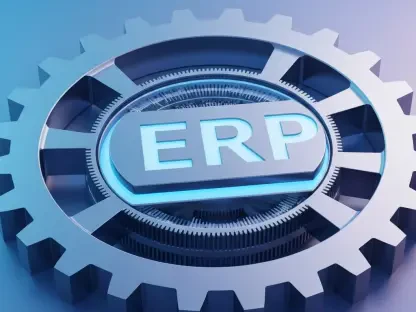In an era where raw data floods enterprises at an unprecedented pace, imagine a tool that transforms chaotic information into precise, actionable insights with just a few clicks. Artificial Intelligence (AI) has emerged as a game-changer, redefining how businesses extract value from unstructured datasets like PDFs, financial reports, and multi-modal content. At the forefront of this revolution stands Nvidia, a company driving cutting-edge advancements in data retrieval and generative AI. This trend of leveraging AI for enhanced data processing, particularly through retrieval-augmented generation (RAG), signals a seismic shift in enterprise workflows, promising efficiency and accuracy like never before.
The Rise of Nvidia and Its AI Innovations
Nvidia’s Evolution and Market Dominance
Nvidia’s transformation from a graphics hardware pioneer founded in 1993 to a titan in AI and GPU-accelerated computing showcases a remarkable journey of adaptation. Initially focused on 3D graphics for gaming, the company redefined its trajectory with the launch of CUDA in 2006, a platform that broadened GPU applications into scientific computing. By 2012, Nvidia’s GPUs became integral to neural network training, cementing its role in AI development. Today, Nvidia commands a significant share of the AI hardware market, with industry reports estimating that over 80% of AI workloads run on its GPUs, reflecting its pervasive influence in generative AI ecosystems.
Beyond hardware, Nvidia’s AI Enterprise suite has seen rapid adoption among businesses seeking scalable AI solutions. This software package, tailored for enterprise needs, supports a range of applications from model training to deployment. The company’s strategic pivot toward integrating hardware with sophisticated software frameworks has positioned it as a holistic provider, addressing the growing demand for AI tools that can handle complex data challenges in real time.
Practical Impact of Nvidia AI Tools
One of Nvidia’s standout innovations, the NeMo Retriever, excels in multi-modal data extraction, enabling enterprises to process diverse content types such as text, tables, and images seamlessly. This tool creates vector-indexed knowledge bases, making raw data accessible for AI-driven insights. For instance, in a test involving Amazon’s 2023 financial report, NeMo Retriever efficiently extracted critical figures and narratives, demonstrating its utility in handling dense, unstructured documents with precision.
Complementing this is the AI-Q Research Assistant, a blueprint within Nvidia’s ecosystem designed for advanced report generation. By ingesting data from PDFs and other sources, it crafts detailed analyses through a reasoning cycle that verifies accuracy. Such real-world applications highlight how Nvidia’s tools tackle enterprise pain points, like sifting through voluminous reports, by automating data synthesis and enhancing conversational AI capabilities.
A further example lies in industries requiring rapid data interpretation, where these technologies reduce manual effort significantly. Financial analysts, for instance, can leverage the AI-Q Assistant to generate summaries and forecasts from quarterly earnings, streamlining decision-making processes. This practical deployment underscores Nvidia’s role in bridging the gap between raw information and strategic outcomes.
Expert Insights on NeMo Retriever and RAG Solutions
Industry leaders have lauded Nvidia’s NeMo Retriever and RAG pipeline for their ability to enhance the accuracy of large language models (LLMs) by grounding responses in relevant, external data. A prominent AI analyst noted that integrating retrieval mechanisms with generative AI addresses persistent issues like hallucinations, where models produce unfounded outputs. This advancement is seen as a critical step toward reliable enterprise AI systems.
However, experts also point to challenges that temper enthusiasm. The dependency on Nvidia GPUs for optimal performance can exclude organizations lacking compatible hardware, creating a barrier to entry. Initial deployment hiccups, such as minor bugs in setup documentation, have been flagged as areas for improvement, though recent updates have mitigated many of these concerns. Despite such hurdles, the consensus remains that Nvidia’s tools are poised to redefine how businesses interact with data.
Another perspective emphasizes the broader implications of RAG solutions for security and compliance. By incorporating guardrails against query-based exploits and ensuring data relevance, these innovations mitigate risks in sensitive sectors like finance and healthcare. Technology consultants argue that this balance of innovation and safety positions Nvidia’s offerings as indispensable for future-proofing AI workflows in regulated environments.
Future Prospects of Nvidia’s Retrieval Technologies
Looking ahead, the evolution of NeMo Retriever and RAG solutions is expected to push boundaries in multi-modal data processing, integrating more diverse inputs like video and real-time feeds. Enhancements in AI safety, through stronger guardrails, are anticipated to bolster trust in automated systems. Such advancements could democratize access to sophisticated data analysis, enabling even mid-sized enterprises to harness AI for competitive advantage.
Yet, potential challenges loom on the horizon. Accessibility remains a concern for users without Nvidia hardware, as the ecosystem’s tight integration with specific GPUs may limit broader adoption. Pricing structures, often requiring consultation with partners, could also pose barriers for smaller firms. Balancing cost with scalability will be crucial to ensure these tools reach a wider audience without compromising on performance.
The ripple effects of these technologies across industries are profound, from finance, where faster data insights could refine investment strategies, to healthcare, where patient data analysis might accelerate diagnoses. However, risks such as over-reliance on a proprietary ecosystem must be weighed against benefits like improved decision-making. As adoption grows, the interplay between innovation and dependency will shape how Nvidia’s retrieval tools influence enterprise landscapes.
Key Takeaways and Forward-Looking Thoughts
Reflecting on Nvidia’s journey, the shift from a graphics-focused entity to an AI powerhouse has marked a defining chapter in tech history. The capabilities of NeMo Retriever and RAG pipelines have showcased a leap in transforming raw data into meaningful insights, validated by expert endorsements as pivotal to enterprise AI. Future possibilities, while promising, carry nuances of accessibility and cost challenges that demand attention.
As a next step, businesses and developers are encouraged to explore Nvidia’s suite of tools to unlock transformative AI applications tailored to specific needs. Staying vigilant about evolving hardware dependencies and pricing models is essential to maximizing benefits. Engaging with authorized partners for customized deployment strategies offers a pathway to integrate these innovations effectively, ensuring that the potential of data-driven decision-making is fully realized in diverse operational contexts.f









